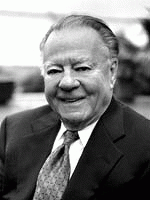Bill Kirschner - William Kirschner, K2 founder
Vashon, Wash. -- H. William Kirschner, 87, the founder of K2 Corp., died April 23, 2006, of pneumonia.
Bill Kirschner was born in Seattle in 1918 and graduated in 1939 from the University of Washington with a degree in engineering. He married Barbara Rankin, and spent the war years managing a mine in Idaho. Following the war he worked in his grandfather’s garage on Vashon Island, and with his father and brothers founded a business making veterinary splints and cages from chew-proof fiberglass. Kirschner Manufacturing became a world-wide supplier of cages for research labs.
Bill was an inveterate tinkerer and inventor. He began experimenting with fiberglass skis during the 1950s, building a series of prototypes, most of which came apart when tested at Crystal Mountain. In 1961 he tried a wet-wrap process that worked well when he skied on the trial pair at Sun Valley. He took this concept to A&T, the Seattle-based ski manufacturing and distributing company, and they agreed to distribute the Holiday. In 1964, the Vashon shop delivered 250 pairs, then 1600 in 1965. In 1967 the ski factory incorporated as a separate business, as K2 Corp., named for the Himalayan peak and for the two Kirschner brothers, Bill and Don.
In an era when the European ski factories Dynamic, Rossignol and Kneissl built fiberglass skis by "armor plating" stiff hickory slalom skis, Kirschner designed the light, resilient foam-core K2 Holiday. The idea was to sell a ski that would work well in soft Western snow. He took the market by storm.
In the spring of 1968 Bill hired Chuck Ferries to develop a line of racing skis. Ferries had recently left his job as coach of the U.S. women’s team, and he began sending prototype skis to Marilyn Cochran for testing. Building skis to Marilyn’s specifications quickly led to success: In 1969 Marilyn Cochran won a World Cup GS on a pair of K2's race skis. By 1971 K2 had set up its own distribution system and severed ties with A&T.
Of his working relationship with Bill, Ferries said “We got along so well. He was a genius kind of guy. He really understood what he was doing. He’d been through the trial and error and knew his process inside and out. The word ‘no’ was not in his vocabulary. No matter what you wanted, he said ‘Yeah, I can do that.’ At the end of the day he’d figured out how to do it.”
At one point, for marketing reasons, K2 decided to put red-white-and-blue plastic on both the top and bottom of the slalom skis. Each of the three colors had a different coefficient of elongation. As the skis cooled after molding, they warped. “There was no way to make a straight ski,” Ferries recalled. “But Bill solved the problem.”
“He was a soft-spoken, kind, nice person,” Ferries said.
Eager to build fiberglass skis, Howard Head is said to have offered to buy the K2 factory. Vashon Island legend says that Kirschner responded "Let's talk," then put off talking for several years.
In 1972, in order to finance rapid growth, Kirschner sold controlling interest in the company to Cummins Inc., an Indiana-based manufacturer of large diesel engines. Cummins helped the factory achieve worldwide distribution, but then sold the company to a group of Seattle investors headed by Jim Garrison. Bill stayed on as chairman of the company throughout this period. At the height of its success, the Vashon Island factory employed about 750 local people.
Kirschner retired in 1982 and began building high-end fiberglass fly-rods. Bill was always interested in efficient engineering solutions. He had his suits retailered so he could put a highball glass in the breast pocket. This freed his hands during ski industry cocktail parties.
In 2001 Bill was inducted into the U. S. National Ski Hall of Fame, honored as "one of the great ski entrepreneurs of the 1960s, the golden years of the United States ski business." Bill received the 2005 Distinguished Service Award from the School of Engineering at the University of Washington.
K2 Corp., now a U.S.-based public corporateion, now operates factories around the world and is among the largest manufacturers of ski, snowboard, baseball and paintball gear. It still employs 220 people on Vashon Island.
. --Seth Masia

